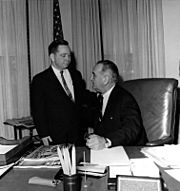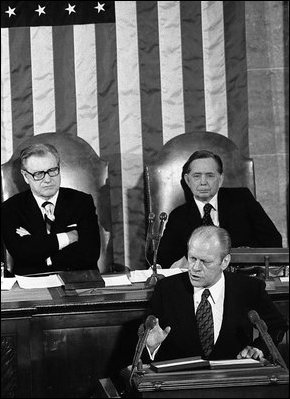Carl Albert facts for kids
Quick facts for kids
Carl Albert
|
|
|---|---|

Portrait of Carl Albert as Speaker of the U.S. House of Representatives
|
|
| 46th Speaker of the United States House of Representatives | |
| In office January 21, 1971 – January 3, 1977 |
|
| Preceded by | John W. McCormack |
| Succeeded by | Tip O'Neill |
| Leader of the House Democratic Caucus | |
| In office January 21, 1971 – January 3, 1977 |
|
| Preceded by | John W. McCormack |
| Succeeded by | Tip O'Neill |
| House Majority Leader | |
| In office January 10, 1962 – January 3, 1971 |
|
| Preceded by | John W. McCormack |
| Succeeded by | Hale Boggs |
| House Majority Whip | |
| In office January 3, 1955 – January 10, 1962 |
|
| Leader | Sam Rayburn |
| Preceded by | Leslie C. Arends |
| Succeeded by | Hale Boggs |
| Member of the U.S. House of Representatives from Oklahoma's 3rd district |
|
| In office January 3, 1947 – January 3, 1977 |
|
| Preceded by | Paul Stewart |
| Succeeded by | Wes Watkins |
| Personal details | |
| Born |
Carl Bert Albert
May 10, 1908 McAlester, Oklahoma, U.S. |
| Died | February 4, 2000 (aged 91) McAlester, Oklahoma, U.S. |
| Resting place | Oak Hill Memorial Park McAlester, Oklahoma |
| Political party | Democratic |
| Spouse |
Mary Sue Harmon
(m. 1942) |
| Children | 2 |
| Relatives | Charles W. Vursell (cousin) |
| Education | University of Oklahoma (BA) St Peter's College, Oxford (BA, BCL) |
| Military service | |
| Allegiance | |
| Branch/service | United States Army Air Forces Army Reserve |
| Years of service | 1941–1946 (Air Forces) 1946-1968 (Reserve) |
| Rank | |
| Unit | Far East Air Service Command |
| Battles/wars | World War II |
| Awards | Bronze Star Medal |
Carl Bert Albert (May 10, 1908 – February 4, 2000) was an American lawyer and politician. He served as the 46th Speaker of the United States House of Representatives from 1971 to 1977. Before that, he represented Oklahoma's 3rd congressional district as a Democrat from 1947 to 1977.
Standing at 5 feet 4 inches tall, Carl Albert was often called the "Little Giant from Little Dixie". He achieved the highest political office of any person from Oklahoma in American history.
Contents
- Carl Albert's Early Life and Education
- Carl Albert's Military Service
- Carl Albert Enters Congress
- Carl Albert as Congressional Majority Leader
- Carl Albert as Speaker of the U.S. House of Representatives
- Carl Albert's Retirement Years
- Carl Albert's Death and Legacy
- Carl Albert's Personal Life
- Images for kids
Carl Albert's Early Life and Education
Carl Albert was born in McAlester, Oklahoma. His father was a coal miner and farmer. Soon after Carl was born, his family moved to Bugtussle, a small town near McAlester. He grew up in a log cabin on his family's farm.
High School and College Years
In high school, Carl was excellent at debate. He was also the student body president. He won a national public speaking contest, which earned him a trip to Europe. He was an active member of the Order of DeMolay, a youth group, and later became a Freemason.
In 1927, Carl Albert started college at the University of Oklahoma. He studied political science. In 1928, he won the National Oratorical Championship, which gave him another trip to Europe. He paid for his college by working in the registrar's office and joining the Reserve Officers' Training Corps (ROTC). He was also a skilled amateur wrestler. He graduated with top honors in 1931.
Studying at Oxford University
After college, Carl Albert received a Rhodes Scholarship. This allowed him to study at the University of Oxford in England. He earned degrees in law from St Peter's College. He returned to the United States in 1934. In 1935, he started his own law practice in Oklahoma City. He worked for oil companies until World War II began.
Carl Albert's Military Service
In 1941, Carl Albert joined the United States Army as a private. He later became a second lieutenant in the United States Army Air Forces.
Family Life During the War
While in the army, Carl Albert married Mary Harmon on August 20, 1942. They got married in Columbia, South Carolina, just before he was sent to the South Pacific. Carl and Mary had two children, Mary Frances and David.
Serving in the Army
Carl Albert worked as a lawyer for the army in the Judge Advocate General Corps. He was assigned to the Far East Air Service Command. He earned a Bronze Star Medal and other awards. He left the Army in 1946 as a lieutenant colonel. He stayed in the Army Reserve and retired in 1968 as a colonel.
Carl Albert Enters Congress
Carl Albert was first elected to Congress in 1946. He was a Democrat who supported President Harry S Truman's policies. These policies included stopping the spread of communism and supporting programs like public housing and federal aid for education.
Mentorship by Sam Rayburn
Sam Rayburn, who was the Speaker of the House, noticed Carl Albert's hard work. Rayburn invited him to informal meetings and advised him to seek important roles. Carl Albert became the House Majority Whip in 1955. After Rayburn's death in 1961, Carl Albert was elected House Majority Leader.
Political Views
Carl Albert described himself as a political moderate. He believed in facing issues based on the situation, not on strict political ideas. He was inducted into the Oklahoma Hall of Fame in 1957.
Carl Albert as Congressional Majority Leader
As Majority Leader, Carl Albert played a key role in passing important laws. He especially helped with health care legislation.
Helping Pass Medicare
Medicare is a federal health insurance program for people aged 65 and older. It was first suggested by President John F. Kennedy. Carl Albert helped guide the bill through Congress. He worked to change House rules to give the majority Democrats more influence. These changes helped pass the Medicare bill, known as the Social Security Act of 1965. He also helped pass other parts of President Lyndon B. Johnson's "Great Society" programs.

Carl Albert supported important civil rights laws. He voted for the Civil Rights Act of 1960, Civil Rights Act of 1964, and Civil Rights Act of 1968. He also voted for the 24th Amendment (which banned poll taxes) and the Voting Rights Act of 1965.
1968 Democratic Convention
Carl Albert also led the 1968 Democratic National Convention in Chicago. This convention was a very challenging time in American history. There were many protests and disagreements during this period.
Carl Albert as Speaker of the U.S. House of Representatives
In January 1971, Carl Albert was elected Speaker of the House of Representatives. This happened during President Richard Nixon's first term.
Watergate and Presidential Succession
During the Watergate scandal in 1973, Carl Albert, as Speaker, handled many requests to investigate President Nixon. He also appointed Felda Looper as the first female House page in 1973.
In 1973, Vice President Spiro Agnew resigned. This meant Carl Albert was next in line to become president if the presidency became empty. This is because of the United States presidential line of succession. President Nixon then nominated Gerald R. Ford to be the new Vice President.

When President Nixon resigned in August 1974, the Vice President's office was again empty. This put Carl Albert next in line for the presidency for a second time. However, President Ford then nominated Nelson Rockefeller as Vice President, who was confirmed.
Carl Albert decided to retire at the end of his term in January 1977. He was never charged with any wrongdoing.
Carl Albert's Retirement Years
After leaving Washington, Carl Albert returned to his hometown of Bugtussle. He turned down many offers for high-paying jobs.
Writing His Memoir
With help from a university professor, Carl Albert published his memoir, called Little Giant, in 1990. An article in The New York Times described him as someone who brought people together. They said he was "trusted for his fairness and integrity." He also gave lectures at the University of Oklahoma and made speeches around the world.
Carl Albert's Death and Legacy
Carl Albert passed away in McAlester, Oklahoma, on February 4, 2000, at the age of 91. He is buried in Oak Hill Cemetery in McAlester.
Honoring His Memory
Many places and institutions in Oklahoma are named after Carl Albert:
- The Carl Albert Center at the University of Oklahoma studies Congress and keeps Carl Albert's historical papers.
- The Carl Albert Indian Health Facility in Ada provides healthcare.
- Durant has Carl Albert Park.
- There is a monument to him in his birthplace of McAlester.
- Carl B. Albert Middle School and Carl B. Albert High School are in Midwest City.
- Carl Albert State College is in Poteau.
- The Carl Albert Federal Building is in McAlester.
- The University of Oxford in England also has a monument to him.
Carl Albert's Personal Life
Carl Albert married Mary Harmon in 1942. They had a son and a daughter. His cousin, Charles W. Vursell, also served as a member of Congress for Illinois.
Images for kids



